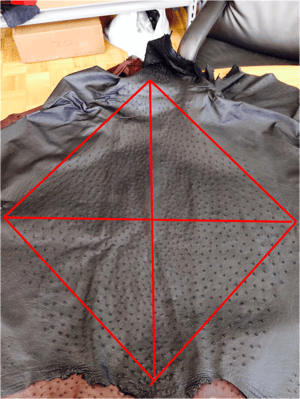 In recent posts, we’ve discussed some of the best types of exotic leather to use for garment projects. Each of these exotic leathers gives you something beyond what common cowhide provides.
In recent posts, we’ve discussed some of the best types of exotic leather to use for garment projects. Each of these exotic leathers gives you something beyond what common cowhide provides.
Python and alligator hides both give garments a unique and striking look—one that immediately identifies the garment as being more than simple cowhide.
But, what about ostrich skins? What makes this exotic leather right for your next garment project?
Softness and Comfort
One of the biggest challenges in making garments out of leather is making them comfortable to wear. If the leather’s too stiff, it will be hard to move in and will crease when flexed.
Ostrich skin is incredibly soft and flexible—whether you order standard or garment-weight skins. These hides can flex easily without creasing, and the garment-weight skins are light enough to make them comfortable to wear.
Choice for Color, Quills, and Thickness
There are a many different options for making a garment out of ostrich skins. While some garment makers prefer to work with special (and more expensive) garment-weight skins, the standard-weight skin is plenty thin for garment panels. In addition, standard ostrich skin is typically stocked in dozens of colors while garment skins are usually made to order which can take several weeks.
Additionally, you can choose between working with only the full quill portion of the hide or the partial and no quill portions as well. Remember that this affects yields greatly. If you plan to use only the full quill area, each skin only yields 10-11 square feet. Whereas, if you can use the full ostrich skin, each skin yields 15-18 square feet.
All told, ostrich skin gives you freedom of choice for appearance and thickness.
Size
Garments typically require large panels. With standard-weight ostrich skin, you have up to 18 square feet of hide to work with and an approximatley 30" x 30" square cut from the center. Altough, if you choose to use the garment-thickness, these skins tend to be approximately 20% smaller.
This large size, and the availability of defect-free, Grade I skins from farms, makes ostrich skin a natural fit for making leather garments.
Appearance
Compared to the intricate colored scales of the python, and the large plates of the alligator, ostrich skin might not seem as exotic in its appearance.
However, the quill follicles in the hide create their own visually distinct appearance while being a bit subtler than other exotic hides. These follicles create a series of raised bumps across the surface of the hide and appear as slightly darker dots of skin when dyed.
These irregularly-placed dots immediately set ostrich hides apart from cow leather, which is why some designers choose to only work with the full-quill portion of the hide, even if it means ordering 30% more ostrich skin since the quills only cover 2/3 of the skin.
Overall, ostrich skin is an excellent material for making garments.
Need help with your ostrich skin order? Get a free consultation today!



